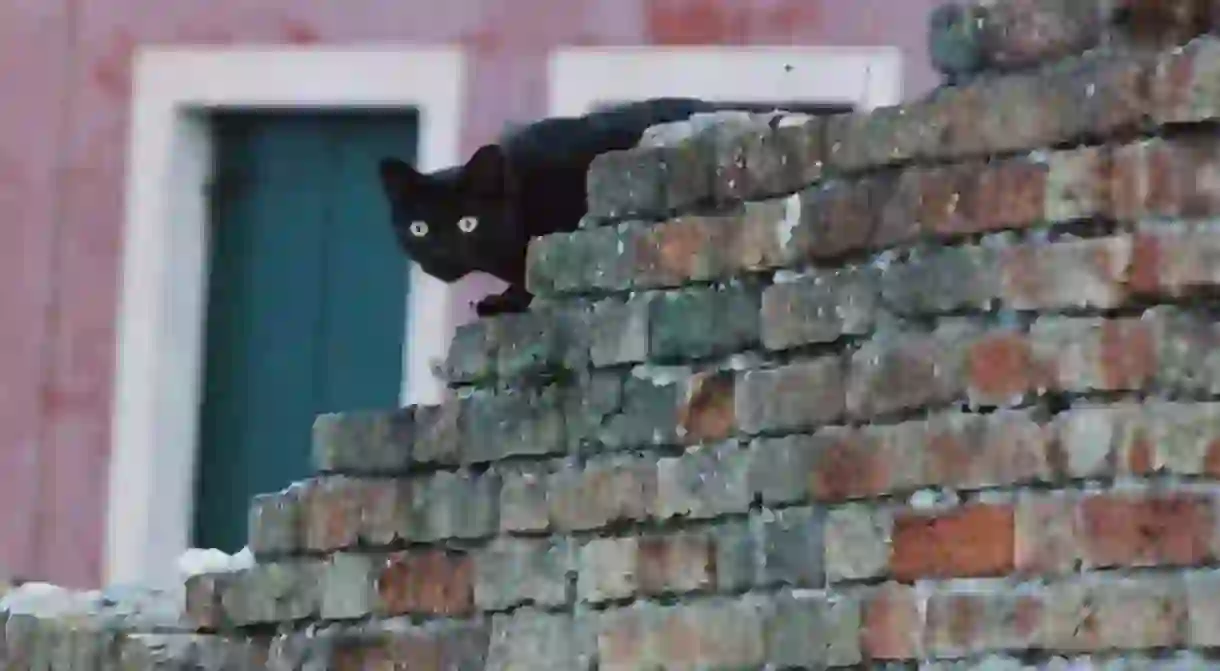What Happened to Venice's Street Cats?

Just a few decades ago, Venice was full of furry cats. They had their own city, one that included roofs of buildings and secret walled gardens. You’d smell the pee they marked their territories with in the back alleys. But in the space of those thirty years, the street cats of Venice have all but vanished. What’s behind this mysterious disappearance? To get to the bottom of this story, let’s start at the beginning.
For centuries, Venetians lived side-by-side with cats. They were brought in by traders from the Middle East and cherished by the local population for their usefulness in keeping away rats, in houses as well as on merchant ships. Special breeds were introduced in the 13th century that were especially adept hunters. They were even credited for helping to save the city from the plague of 1348 by keeping disease carrying rats at bay. Famous cats were even a part of Venetian history. The cat of Doge Francesco Morosini was brought everywhere with the naval commander, including into war. Nini, a white cat who lived at the Caffe dei Frari was an international celebrity and he even had a wake held in his honor when he died in 1894.

The main character in our tale will be a British lady who arrived in Venice in 1965, at a time when many of the cats of the city were sick and in need of organized care. Her name was Helena Sanders. You can see her in this delightful TV interview, explaining how she came to be an advocate for Venetian street cats and how surprised she was at the resistance that she was met with.
She sounds like a sweet grandmother, but in fact she was promoting quite a progressive program. Sanders was among the first in Italy to practice TNR, or trap-neuter-return. In the 1950s, animal welfare activists in the U.K began to trap alley cats in order to sterilize and neuter them before returning them to their outdoor homes. This was not only a way to eradicate diseases, but it also allowed them to control the population, so that unwanted colonies could be eliminated over time. This practice, however, did not find favor with local people. The Venetian lawyer interviewed in the video, Umberto Corado, argues simply that the cats serve a purpose in the city – their historic purpose of keeping the rats away and that their numbers were quite normal.
In pre-modern times, animals were kept primarily for their use value. Dogs were for guarding, cats for catching mice and so on. Just 70 years ago, it was unheard of to have a cat live entirely indoors. It just wasn’t possible until the mid-20th century. The development of refrigeration and canned cat food meant that cats didn’t have to hunt. The marketing of cat litter began in the 1960s, so they wouldn’t need to go out for the bathroom. The practice of neutering became available in the 30s and spaying in the 50s, so that cats wouldn’t wander outside searching for mates.
It’s important to understand the TNR movement as a part of a shift in the cultural mindset in general. The cat and the dog were entering the bourgeois family circle in these decades as the family pet. Just as the place they entered was sanitized and sterilized, so they themselves needed to become clean and sterile. As John Berger writes in his essay on animals, “the pet is… sexually isolated, deprived of almost all other animal contact, and fed with artificial foods… they are creatures of their owner’s way of life.”
The street cat, which found its home within the community, was out. The domestic cat of the individual home was in. The campaign taken up by Sanders’ association, Dingo, followed this sea change. The news clip states that Sanders encountered a population of some 38,000 cats. Her organization, Dingo, claims it stabilized a population of 12,000 cats that roamed the streets of Venice, bringing the numbers down to 2,000 over time with support from the city government.

Nowadays, street cats are significantly fewer than a few decades ago. Though you’ll still find cats lounging about at the bookstore Acqua Alta and in the gardens of the hospital, they are by no means the regular feature of Venetian life they once were. In this way, they have become a metaphor for the Venetians themselves. Last year, an article in La Nuova Venezia followed a meeting of a group called Awakening, made up of photo-journalists, environmental groups and cat lovers. Representative Marco Secchi says, “the cats disappeared like Venetians are disappearing.” They claim that the enormous influx of tourists that floods the city every year has made it difficult for cats to live in the streets and squares that were their homes. While the statement is uncorroborated, it’s not hard to see why this feels poignantly true. This is the story of the human residents of Venice, who are being pushed out en masse by the booming industry of mass tourism, their houses converted into profitable rentals and hotels.
In just 30 years, the city has lost half of its residents, going from 120,000 to about about 55,000 currently. Meanwhile, the number of visitors has skyrocketed up to 20 million annually, half of which don’t stay even one night. Along with these demographic shifts have come social and cultural changes. Local bakeries, fish markets and butchers are slowly encroached upon by easy and quick supermarket culture. Artisan boutiques are closing and dime-a-dozen souvenir shops are popping up. Even parts of Venice that were unsafe, like Giudecca and Castello, are now prime real estate for fancy restaurants and luxury hotels. The alley cats who roamed free and owned the city’s back streets represent a kind of wildness and autonomy that Venetians have lost.














